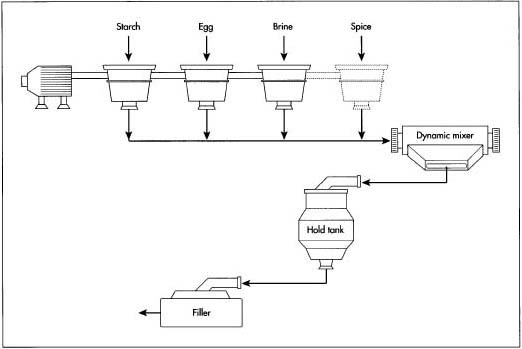Mayonnaise
Background
Mayonnaise is a cold, emulsification used as sauce or as a condiment. It is made by blending egg yolks and oil, then flavored with varying combinations of vinegar, mustard, herbs and spices. Mayonnaise is often used as base for creamy-type salad dressings.
History
Food historians offer four possible theories for the origin of mayonnaise. The most popular story dates to June 28, 1756, when the French Duke Richelieu captured Port Mayon on the Spanish island of Minorca. When preparing the victory feast, the duke's chef was forced to substitute olive oil for cream in a sauce. Unexpectedly pleased with the result, the chef christened the result "mahonnaise" in honor of the place of victory.
Carame, a French food writer and author of Cuisinier parisien: Trarte des entries froids believed the word was derived from the French verb manier, meaning to stir. Another food expert, Prosper Montagne maintained that the origin lay in the Old French word moyeu, meaning egg yolk.
Still others insist that the creamy sauce was a specialty of the town of Bayonne in southwest France. Thus, what was originally called bayonnaise was later modified to mayonnaise.
Regardless of its origins, mayonnaise quickly because a popular sauce and spread in European cuisine. In the early 1900s, a German immigrant named Richard Hellmann opened a delicatessen in New York City. The salads that his wife made with her homemade mayonnaise were particularly popular items. When customers began to ask if they could purchase the mayonnaise itself, the Hellmans produced it in bulk and sold it by weight in small wooden butter-measuring vessels.
Eventually the Hellmans were packing their mayonnaise in glass jars. In 1913, they built their first factory in Astoria. A company in California, Best Foods Inc., was also enjoying success with their version of mayonnaise. In 1932, Best Foods acquired the Hellman's brand.
A variation of mayonnaise, made with a cooked based and labeled salad dressing, was developed by National Dairy Products in 1933 at the Century of Progress World's Fair in Chicago. It would eventually become known as Kraft Miracle Whip Salad Dressing.
Raw Materials
Mayonnaise is regulated by the U.S. Food and Drug Administration's Standard of Identity. It must contain at least 65% oil by weight, vinegar, and egg or egg yolks. Spices and other natural seasonings may added with the exception of turmeric and saffron. These would give the mayonnaise a yellow hue and thus appear to contain added egg yolks.
The FDA's Standard of Identity requirements for salad dressing are 30% vegetable oil, 4% egg yolk, vinegar or lemon juice, and spices.
Soybean oil is the most common type of oil used in the production of mayonnaise. Vinegar is distilled from distilled alcohol. Lemon or lime juice is diluted with water.

The eggs are subjected to pasteurization by heating them without actually cooking them. Low-fat versions are made with egg whites. To replace the fat from the missing egg yolk, modified food starches are added so that the low-fat mayonnaise retains the creamy texture and thickness of real mayonnaise. These food starches can be made from corn, gums, or agar agar (a seaweed extraction).
Salt is added to enhance flavor. The amount equals approximately 1/16 teaspoon of salt per tablespoon serving of mayonnaise. Preservatives such as calcium disodium EDTA are added to increase shelf-life.
The Manufacturing Process
Creating the emulsion
-
1 A continuous blending system is employed to sustain the correct degree of emulsification. An emulsion (known technically as a colloid) occurs when the blending of two liquids, in this case vinegar and oil, causes one of the liquids to form small droplets that are dispersed throughout the other liquid.
The blend of vinegar and oil moves continuously through a series of positive replacement pumps. These pumps feature a cavity or set of cavities fitted with rotary impellers. A regulated pumping action causes the cavities to fill and empty. The impellers move the blended fluid from one cavity to another
Adding ingredients
- 2 Pre-measured ingredients are piped in through openings in the sides of the pumps or from spigots overhead.
Bottling the mayonnaise
- 3 The mayonnaise is moved through the pumping system to the bottling station. Pre-sterilized jars move along conveyer belts as premeasured amounts of mayonnaise are poured into the jars. The jars are sealed with metal screwcaps. They are not vacuum-sealed.
Quality Control
All raw materials are check for freshness when they arrive at the processing plant. Stored materials are tested periodically as well. Samples of the mayonnaise are drawn off and taste-tested during the manufacturing process.
Where to Learn More
Books
Coyle, L. Patrick Jr. The World Encyclopedia of Food New York: Facts on File, 1982.
Trager, James. The Food Chronology. New York: Henry Holt, 1995.
Other
Association for Dressings and Sauces. http://www.dressings-sauces.org/ (October 2000).
Kraft Unit Operations. http://www.kraftunitops.com/ (October 2000).
— Mary McNulty
We would like to have some information regarding
(a)machinery used for manufacturing mayonnaise and price for the machinery.
(b) more information on the ingredients used
(c) how it is manufactured and packed in plastic containers.250 grams and 500 grams.
thanking you in advance and waiting for your reply.